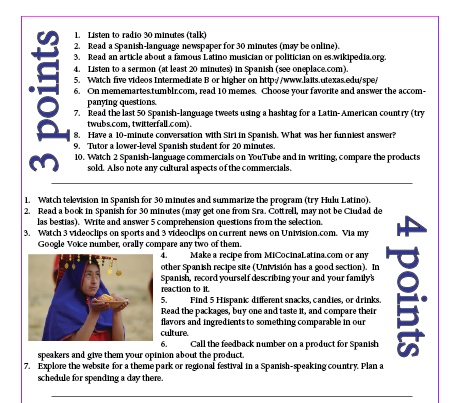 When I posted last year about my latest update on the Elige tu propia aventura homework choice activity, the post quickly became one of the top 10 of the year. Accordingly, I frequently receive requests for my list of options and how I divided them into a point system. The problem is that I was experimenting with InDesign to develop my ebook resources and chose it to make my AP syllabus and the Aventura document – and your average teacher isn’t going around with InDesign on her computer. So the best I could offer was a PDF. Plus, I’ve only done this activity with intermediate and pre-advanced students and many teachers wonder what the options would look like for lower levels.
When I posted last year about my latest update on the Elige tu propia aventura homework choice activity, the post quickly became one of the top 10 of the year. Accordingly, I frequently receive requests for my list of options and how I divided them into a point system. The problem is that I was experimenting with InDesign to develop my ebook resources and chose it to make my AP syllabus and the Aventura document – and your average teacher isn’t going around with InDesign on her computer. So the best I could offer was a PDF. Plus, I’ve only done this activity with intermediate and pre-advanced students and many teachers wonder what the options would look like for lower levels.
Wait, what?
Screeching halt.
If you haven’t been with me for the journey through giving up the pretense that trying to excessively manipulate my students’ out-of-class time is going to predict to me what they learn, you could always browse through my choice tag. If you don’t have that kind of time, here’s a run-down:
- Autonomy and intrinsic motivation are high predictors of success in learning.
- Language for communicative purposes cannot be learned in isolation.
- Frustration is common in traditional homework because there’s no one around to help.
- Frustration blocks language acquisition.
- I give two and only two homework assignments per week.
- These assignments are always the same: do an aventura activity and post a free-topic blog
- Student autonomy in these assignments is very important to me.
- These two graded assignments free me from grading or entering grades for most other formative activities.
- As time passed I realized that not all assignments are worth the same either in time commitment or in usefulness for language acquisition.
- Assigning choices a point value allowed me to require students to challenge themselves and to adapt the same list for various learning levels.
- This idea is one of my most widely-used and several other teachers have developed their own lists and systems.
I’m so excited and impressed with how other teachers have adopted and adapted this idea and thought it would be helpful to link all the documents for you here. Plus, I took all the content from my InDesign file and put it in a Google Doc for you to copy/paste and adapt for your situation.
Choice activity documents
My options and point system
Kara Jacobs‘ system
Noah Geisel‘s system
– some Pinterest ideas Noah found useful
Laura Sexton’s options – NEW April ’15: See all her choice stuff in one place!
Tana Krohn‘s list
Bethanie Carlson Drew’s updated list (and I stole the name from her!)
Katherine Matheson’s version
And how could I leave out-
The Creative Language Class’s Real World Homework
(developed completely on their own creative genius!)
17 Comments
Comments are closed.





I love this idea, but I have a quick question. How do I find the apps (like Ruzzle and Fotos y palabra) in Spanish? I am using an iPhone and have looked in the app store and have looked for ways to change the settings. Thanks!
Hi Briana – I’m glad you think the idea will be useful for you!
Here is the Ruzzle app. If I remember correctly there’s a flag or something you can tap to change the language. It has a ton of languages.
I’m not finding Fotos y Palabras anymore either but here is something similar.
And if you need help with the game answers in Spanish I use this website. I hope it will help you.
Thanks, yet again, for an incredibly timely article! Having just blogged about changes needed in approach due to a shortened semester you put together all the resources I need to start crafting my own list. Being an Asian language teacher will bring its own wrinkles to this and I’ll be sure to share what I learn as I do. Gracias again to you, and the whole #langchat crew, for your, and their, willingness to share, encourage and grow our practice!
Colleen
Thanks for all you do as well, Colleen!
[…] We’ll present why and how we each have accessed students’ intrinsic motivation by letting them choose how they interact with language outside our classrooms. (Session 1154: Saturday, 2:00-3:00 P.M., […]
[…] this year, I’ve started using Edmodo for my students’ weekly real-world homework and blogging assignments. We don’t really use this in the classroom, but so far it’s […]
[…] in the worthwhile journey to infuse more autonomy into homework in this popular post from August, Putting homework in their hands: Sample systems. You can get the handout and see the slides from this popular ACTFL presentation via a blog post […]
[…] has a blog post where she posts links to several other teachers that are doing homework choice in a variety of ways […]
[…] choice in midterms. I, like many others, have already stolen Sara-Elizabeth Cottrell’s choice in homework system for this year, and I was happy with the results. So I read this person’s idea, about […]
[…] a homework choice, students can choose to listen to the pronunciations from their vocabulary list (if you have one) […]
[…] people are generally happier when they have a say. Why not let students decide things like what to do for homework, what text to read next, what kind of project to undertake, or in what order to do certain […]
[…] go to deeply into what I mean by homework choice because you can see a pretty good summary here in one of the most popular posts of 2014. After you look at that, you may have a question […]
I love this idea but have a question. How do you know students did some of the activities and then how do you grade them in an efficient way? I teach high school and I’m sure many parents of the kids I teach would sign a form saying the student did the work when they did not. Ex: how do you know if they spent an hour on fb or not in Spanish? Or ordered in Spanish in a restaurant? How do you keep up with which items a student has done or not done? I did something similar to this years ago but abandoned it after it was obvious students/parents were lying about task completion and it was hard to efficiently keep up with it in the Gradebook
Great questions, Beth, and ones that I did not have to deal with a lot in my program. If you have a lot of trouble with students lying, my first step would be to cull all the options that don’t have an explicit proof option – such as, playing for an hour on Facebook. And tell students that. Students AND parents need to know that there are fun, motivating options that encourage student engagement and language acquisition that they are NOT allowed to do because they have been deceptive. That is THEIR fault and not yours. So, start by using only the options that allow for a good proof: they have to print out the plane ticket (before the “purchase” stage of course). They have to email you the Pinterest board. They have to video the end product of their cooking adventure and a family member’s reaction. For the ordering in Spanish at a restaurant, I required students to video themselves doing it and several came in with the video on their phone to show me. They recorded video of themselves using the U-Scan. And so on.
As far as grading, this is a departure from proficiency-based / standards-based grading for me. Because this is an assignment that every student does every week, it’s a flat 75 points. Either you did it and proved it (75) or you didn’t (0 until it’s made up). If the grade is less than 75, they know the did not do one of the things I require: my students being intermediates, they were required to do it in Spanish. Sometimes they would submit it without the “what I learned” section. But I offered no feedback. If they cared to improve the grade, they could check what was missing and repair it, or not.
I hope this helps and your students let you help them take advantage of this the opportunity!
[…] don’t forget that I’ve posted links (also copied below) for eight homework choice systems you can mine for gems from others, too. I […]
[…] was out perusing the Internet a few weeks ago, when I came upon musicuentos.com’s Homework Choices and I said, “OMG, I need […]